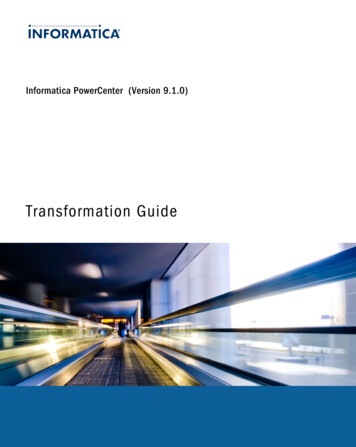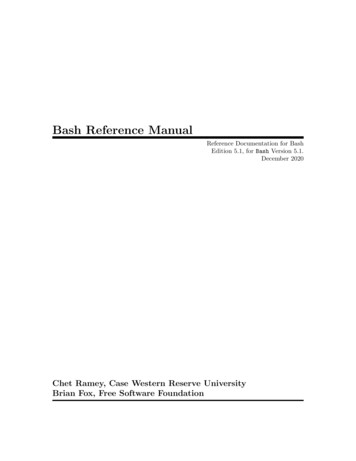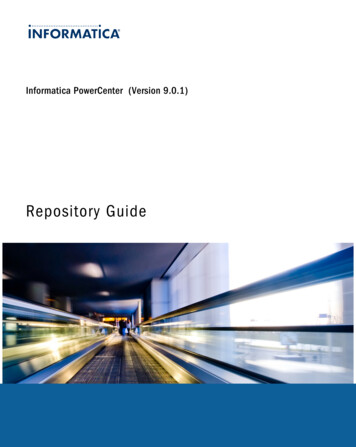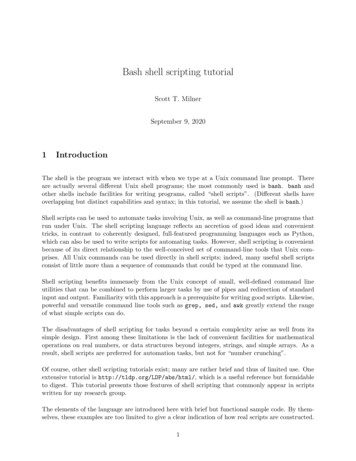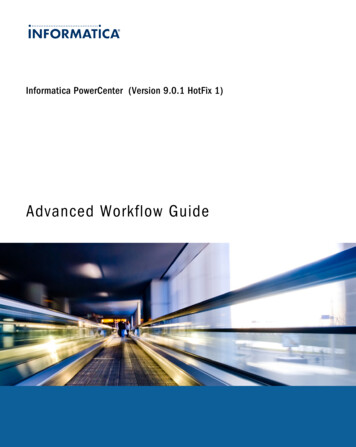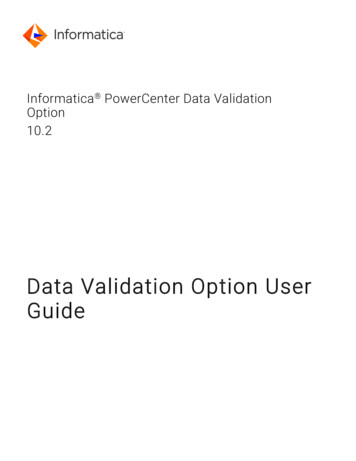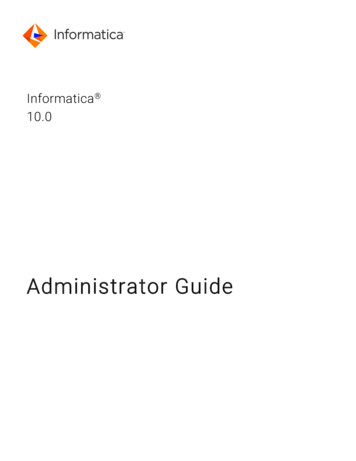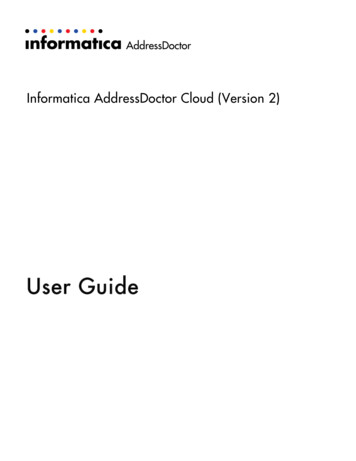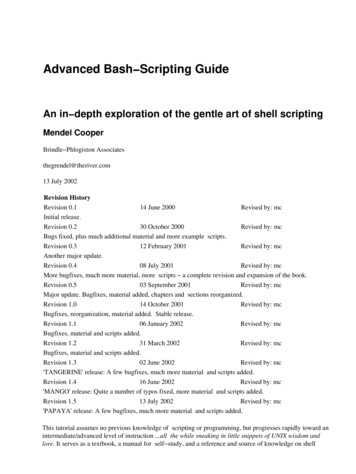
Transcription
Advanced Bash Scripting GuideAn in depth exploration of the gentle art of shell scriptingMendel CooperBrindle Phlogiston Associatesthegrendel@theriver.com13 July 2002Revision HistoryRevision 0.114 June 2000Revised by: mcInitial release.Revision 0.230 October 2000Revised by: mcBugs fixed, plus much additional material and more example scripts.Revision 0.312 February 2001Revised by: mcAnother major update.Revision 0.408 July 2001Revised by: mcMore bugfixes, much more material, more scripts a complete revision and expansion of the book.Revision 0.503 September 2001Revised by: mcMajor update. Bugfixes, material added, chapters and sections reorganized.Revision 1.014 October 2001Revised by: mcBugfixes, reorganization, material added. Stable release.Revision 1.106 January 2002Revised by: mcBugfixes, material and scripts added.Revision 1.231 March 2002Revised by: mcBugfixes, material and scripts added.Revision 1.302 June 2002Revised by: mc'TANGERINE' release: A few bugfixes, much more material and scripts added.Revision 1.416 June 2002Revised by: mc'MANGO' release: Quite a number of typos fixed, more material and scripts added.Revision 1.513 July 2002Revised by: mc'PAPAYA' release: A few bugfixes, much more material and scripts added.This tutorial assumes no previous knowledge of scripting or programming, but progresses rapidly toward anintermediate/advanced level of instruction .all the while sneaking in little snippets of UNIX wisdom andlore. It serves as a textbook, a manual for self study, and a reference and source of knowledge on shell
scripting techniques. The exercises and heavily commented examples invite active reader participation,under the premise that the only way to really learn scripting is to write scripts.The latest update of this document, as an archived, bzip2 ed "tarball" including both the SGML source andrendered HTML, may be downloaded from the author's home site. See the change log for a revision history.DedicationFor Anita, the source of all the magic
Advanced Bash Scripting GuideTable of ContentsChapter 1. Why Shell Programming?.1Chapter 2. Starting Off With a Sha Bang.32.1. Invoking the script.52.2. Preliminary Exercises.6Part 2. Basics.6Chapter 3. Exit and Exit Status.7Chapter 4. Special Characters.9Chapter 5. Introduction to Variables and Parameters.275.1. Variable Substitution.275.2. Variable Assignment.295.3. Bash Variables Are Untyped.315.4. Special Variable Types.32Chapter 6. Quoting.36Chapter 7. Tests.427.1. Test Constructs.427.2. File test operators.487.3. Comparison operators (binary).517.4. Nested if/then Condition Tests.567.5. Testing Your Knowledge of Tests.57Chapter 8. Operations and Related Topics.588.1. Operators.588.2. Numerical Constants.65Part 3. Beyond the Basics.66Chapter 9. Variables Revisited.679.1. Internal Variables.679.2. Manipulating Strings.839.2.1. Manipulating strings using awk.879.2.2. Further Discussion.889.3. Parameter Substitution.889.4. Typing variables: declare or typeset.979.5. Indirect References to Variables.989.6. RANDOM: generate random integer.1009.7. The Double Parentheses Construct.105Chapter 10. Loops and Branches.10710.1. Loops.10710.2. Nested Loops.11710.3. Loop Control.11810.4. Testing and Branching.120i
Advanced Bash Scripting GuideTable of ContentsChapter 11. Internal Commands and Builtins.12811.1. Job Control Commands.146Chapter 12. External Filters, Programs and Commands.15112.1. Basic Commands.15112.2. Complex Commands.15412.3. Time / Date Commands.16112.4. Text Processing Commands.16412.5. File and Archiving Commands.18112.6. Communications Commands.19712.7. Terminal Control Commands.20212.8. Math Commands.20312.9. Miscellaneous Commands.212Chapter 13. System and Administrative Commands.222Chapter 14. Command Substitution.246Chapter 15. Arithmetic Expansion.251Chapter 16. I/O Redirection.25216.1. Using exec.25416.2. Redirecting Code Blocks.25716.3. Applications.261Chapter 17. Here Documents.263Chapter 18. Recess Time.270Part 4. Advanced Topics.270Chapter 19. Regular Expressions.27219.1. A Brief Introduction to Regular Expressions.27219.2. Globbing.275Chapter 20. Subshells.277Chapter 21. Restricted Shells.280Chapter 22. Process Substitution.282Chapter 23. Functions.28423.1. Complex Functions and Function Complexities.28623.2. Local Variables.29323.2.1. Local variables make recursion possible.294Chapter 24. Aliases.296Chapter 25. List Constructs.299ii
Advanced Bash Scripting GuideTable of ContentsChapter 26. Arrays.302Chapter 27. Files.316Chapter 28. /dev and /proc.31728.1. /dev.31728.2. /proc.317Chapter 29. Of Zeros and Nulls.322Chapter 30. Debugging.325Chapter 31. Options.331Chapter 32. Gotchas.334Chapter 33. Scripting With Style.33933.1. Unofficial Shell Scripting Stylesheet.339Chapter 34. Miscellany.34234.1. Interactive and non interactive shells and scripts.34234.2. Shell Wrappers.34334.3. Tests and Comparisons: Alternatives.34634.4. Recursion.34734.5. "Colorizing" Scripts.34834.6. Optimizations.35234.7. Assorted Tips.35334.8. Security Issues.35934.9. Portability Issues.36034.10. Shell Scripting Under Windows.360Chapter 35. Bash, version 2.361Chapter 36. Endnotes.36636.1. Author's Note.36636.2. About the Author.36636.3. Tools Used to Produce This Book.36636.3.1. Hardware.36636.3.2. Software and Printware.36636.4. Credits.367Bibliography.369Appendix A. Contributed Scripts.374Appendix B. A Sed and Awk Micro Primer.404B.1. Sed.404B.2. Awk.407iii
Advanced Bash Scripting GuideTable of ContentsAppendix C. Exit Codes With Special Meanings.409Appendix D. A Detailed Introduction to I/O and I/O Redirection.411Appendix E. Localization.413Appendix F. History Commands.415Appendix G. A Sample .bashrc File.416Appendix H. Converting DOS Batch Files to Shell Scripts.425Appendix I. Exercises.429I.1. Analyzing Scripts.429I.2. Writing Scripts.430Appendix J. Copyright.437iv
Chapter 1. Why Shell Programming?A working knowledge of shell scripting is essential to everyone wishing to become reasonably adept atsystem administration, even if they do not anticipate ever having to actually write a script. Consider that as aLinux machine boots up, it executes the shell scripts in /etc/rc.d to restore the system configuration andset up services. A detailed understanding of these startup scripts is important for analyzing the behavior of asystem, and possibly modifying it.Writing shell scripts is not hard to learn, since the scripts can be built in bite sized sections and there is onlya fairly small set of shell specific operators and options [1] to learn. The syntax is simple andstraightforward, similar to that of invoking and chaining together utilities at the command line, and there areonly a few "rules" to learn. Most short scripts work right the first time, and debugging even the longer ones isstraightforward.A shell script is a "quick and dirty" method of prototyping a complex application. Getting even a limitedsubset of the functionality to work in a shell script, even if slowly, is often a useful first stage in projectdevelopment. This way, the structure of the application can be tested and played with, and the major pitfallsfound before proceeding to the final coding in C, C , Java, or Perl.Shell scripting hearkens back to the classical UNIX philosophy of breaking complex projects into simplersubtasks, of chaining together components and utilities. Many consider this a better, or at least moreesthetically pleasing approach to problem solving than using one of the new generation of high poweredall in one languages, such as Perl, which attempt to be all things to all people, but at the cost of forcing youto alter your thinking processes to fit the tool.When not to use shell scripts resource intensive tasks, especially where speed is a factor (sorting, hashing, etc.) procedures involving heavy duty math operations, especially floating point arithmetic, arbitraryprecision calculations, or complex numbers (use C or FORTRAN instead) cross platform portability required (use C instead) complex applications, where structured programming is a necessity (need typechecking of variables,function prototypes, etc.) mission critical applications upon which you are betting the ranch, or the future of the company situations where security is important, where you need to guarantee the integrity of your system andprotect against intrusion, cracking, and vandalism project consists of subcomponents with interlocking dependencies extensive file operations required (Bash is limited to serial file access, and that only in a particularlyclumsy and inefficient line by line fashion) need multi dimensional arrays need data structures, such as linked lists or trees need to generate or manipulate graphics or GUIs need direct access to system hardware need port or socket I/O need to use libraries or interface with legacy code proprietary, closed source applications (shell scripts are necessarily Open Source)If any of the above applies, consider a more powerful scripting language, perhaps Perl, Tcl, Python, orpossibly a high level compiled language such as C, C , or Java. Even then, prototyping the application as ashell script might still be a useful development step.Chapter 1. Why Shell Programming?1
Advanced Bash Scripting GuideWe will be using Bash, an acronym for "Bourne Again Shell" and a pun on Stephen Bourne's now classicBourne Shell. Bash has become a de facto standard for shell scripting on all flavors of UNIX. Most of theprinciples dealt with in this book apply equally well to scripting with other shells, such as the Korn Shell,from which Bash derives some of its features, [2] and the C Shell and its variants. (Note that C Shellprogramming is not recommended due to certain inherent problems, as pointed out in an October, 1993Usenet posting by Tom Christiansen).What follows is a tutorial on shell scripting. It relies heavily on examples to illustrate various features of theshell. As far as possible, the example scripts have been tested, and some of them may even be useful in reallife. The reader should use the actual examples in the source archive (something or other.sh),[3] give them execute permission (chmod u rx scriptname), then run them to see what happens.Should the source archive not be available, then cut and paste from the HTML, pdf, or text renderedversions. Be aware that some of the scripts below introduce features before they are explained, and this mayrequire the reader to temporarily skip ahead for enlightenment.Unless otherwise noted, the book author wrote the example scripts that follow.Chapter 1. Why Shell Programming?2
Chapter 2. Starting Off With a Sha BangIn the simplest case, a script is nothing more than a list of system commands stored in a file. At the very least,this saves the effort of retyping that particular sequence of commands each time it is invoked.Example 2 1. cleanup: A script to clean up the log files in /var/log# cleanup# Run as root, of course.cd /var/logcat /dev/null messagescat /dev/null wtmpecho "Logs cleaned up."There is nothing unusual here, just a set of commands that could just as easily be invoked one by one fromthe command line on the console or in an xterm. The advantages of placing the commands in a script gobeyond not having to retype them time and again. The script can easily be modified, customized, orgeneralized for a particular application.Example 2 2. cleanup: An enhanced and generalized version of above script.#!/bin/bash# cleanup, version 2# Run as root, of course.LOG DIR /var/logROOT UID 0#LINES 50#E XCD 66#E NOTROOT 67#Only users with UID 0 have root privileges.Default number of lines saved.Can't change directory?Non root exit error.if [ " UID" ne " ROOT UID" ]thenecho "Must be root to run this script."exit E NOTROOTfiif [ n " 1" ]# Test if command line argument present (non empty).thenlines 1elselines LINES # Default, if not specified on command line.fi# Stephane Chazelas suggests the following,# as a better way of checking command line arguments,# but this is still a bit advanced for this stage of the tutorial.##E WRONGARGS 65 # Non numerical argument (bad arg format)##case " 1" inChapter 2. Starting Off With a Sha Bang3
Advanced Bash Scripting Guide#"") lines 50;;#*[!0 9]*) echo "Usage: basename 0 file to cleanup"; exit E WRONGARGS;;#*) lines 1;;#esac##* Skip ahead to "Loops" chapter to decipher all this.cd LOG DIRif [ pwd ! " LOG DIR" ]# orif [ " PWD" ! " LOG DIR" ]# Not in /var/log?thenecho "Can't change to LOG DIR."exit E XCDfi # Doublecheck if in right directory, before messing with log file.# far more efficient is:## cd /var/log {#echo "Cannot change to necessary directory." &2#exit E XCD;# }tail lines messages mesg.temp # Saves last section of message log file.mv mesg.temp messages# Becomes new log directory.# cat /dev/null messages#* No longer needed, as the above method is safer.cat /dev/null wtmp #echo "Logs cleaned up."': wtmp' and ' wtmp'have the same effect.exit 0# A zero return value from the script upon exit# indicates success to the shell.Since you may not wish to wipe out the entire system log, this variant of the first script keeps the last sectionof the message log intact. You will constantly discover ways of refining previously written scripts forincreased effectiveness.The sha bang ( #!) at the head of a script tells your system that this file is a set of commands to be fed to thecommand interpreter indicated. The #! is actually a two byte [4] "magic number", a special marker thatdesignates a file type, or in this case an executable shell script (see man magic for more details on thisfascinating topic). Immediately following the sha bang is a path name. This is the path to the program thatinterprets the commands in the script, whether it be a shell, a programming language, or a utility. Thiscommand interpreter then executes the commands in the script, starting at the top (line 1 of the script),ignoring comments. cl#!/bin/sed f#!/usr/awk fChapter 2. Starting Off With a Sha Bang4
Advanced Bash Scripting GuideEach of the above script header lines calls a different command interpreter, be it /bin/sh, the default shell(bash in a Linux system) or otherwise. [6] Using #!/bin/sh, the default Bourne Shell in most commercialvariants of UNIX, makes the script portable to non Linux machines, though you may have to sacrifice a fewBash specific features (the script will conform to the POSIX [7] sh standard).Note that the path given at the "sha bang" must be correct, otherwise an error message, usually "Commandnot found" will be the only result of running the script.#! can be omitted if the script consists only of a set of generic system commands, using no internal shelldirectives. The second example, above, requires the initial #!, since the variable assignment line, lines 50,uses a shell specific construct. Note that #!/bin/sh invokes the default shell interpreter, which defaults to/bin/bash on a Linux machine.This tutorial encourages a modular approach to constructing a script. Makenote of and collect "boilerplate" code snippets that might be useful in futurescripts. Eventually you can build a quite extensive library of nifty routines.As an example, the following script prolog tests whether the script has beeninvoked with the correct number of parameters.if [ # ne Number of expected args ]thenecho "Usage: basename 0 whatever"exit WRONG ARGSfi2.1. Invoking the scriptHaving written the script, you can invoke it by sh scriptname, [8] or alternatively bashscriptname. (Not recommended is using sh scriptname, since this effectively disables reading fromstdin within the script.) Much more convenient is to make the script itself directly executable with achmod.Either:chmod 555 scriptname (gives everyone read/execute permission) [9]orchmod rx scriptname (gives everyone read/execute permission)chmodu rx scriptname (gives only the script owner read/execute permission)Having made the script executable, you may now test it by ./scriptname. [10] If it begins with a"sha bang" line, invoking the script calls the correct command interpreter to run it.As a final step, after testing and debugging, you would likely want to move it to /usr/local/bin (asroot, of course), to make the script available to yourself and all other users as a system wide executable. Thescript could then be invoked by simply typing scriptname [ENTER] from the command line.2.1. Invoking the script5
Advanced Bash Scripting Guide2.2. Preliminary Exercises1. System administrators often write scripts to autom
Advanced Bash Scripting Guide Chapter 1. Why Shell Programming? 2. Chapter 2. Starting Off With a Sha Bang In the simplest case, a script is nothing more than a list of system commands stored in a file. At the very least, this saves the effort of retyping that particular sequence of commands each time it is invoked.
